1
Video summary
In a nutshell
Demand for high-skilled workers who perform cognitive tasks has increased dramatically in the United States over the past four decades, with the biggest change between 1980 and 2000. This policy brief shows that the increase in demand was not experienced equally by both genders: despite rapid growth in employment in high-paying occupations, the probability that a college-educated man was employed in such a job fell, while the prospects for college-educated women improved. The key driver seems to be growing demand for social skills, such as empathy, communication, emotion recognition and verbal expression, in which evidence from psychological research indicates that women have a comparative advantage.
Demand for high-skilled workers who perform cognitive tasks has increased dramatically in the United States over the past four decades, with the biggest change between 1980 and 2000. This policy brief shows that the increase in demand was not experienced equally by both genders: despite rapid growth in employment in high-paying occupations, the probability that a college-educated man was employed in such a job fell, while the prospects for college-educated women improved. The key driver seems to be growing demand for social skills, such as empathy, communication, emotion recognition and verbal expression, in which evidence from psychological research indicates that women have a comparative advantage.
Opportunities for action
1
In a world with accelerating automation, the results of this research suggest the growing importance of the acquisition of social skills. In other words, as technology increasingly seems to replace non-social labor, perhaps what is left is more interpersonal work.
2
This has implications for the kind of skills that will be most valued in the modern labor market. Advertisements for well paid jobs are more likely to feature ‘social words’, such as communication, teamwork, collaboration and negotiation.
3
Hence it seems important that our education systems – be it our children’s schools or more specific job training programs – should emphasize and teach not just ‘technical’ skills but also social and interpersonal skills.
1
In a world with accelerating automation, the results of this research suggest the growing importance of the acquisition of social skills. In other words, as technology increasingly seems to replace non-social labor, perhaps what is left is more interpersonal work.
2
This has implications for the kind of skills that will be most valued in the modern labor market. Advertisements for well paid jobs are more likely to feature ‘social words’, such as communication, teamwork, collaboration and negotiation.
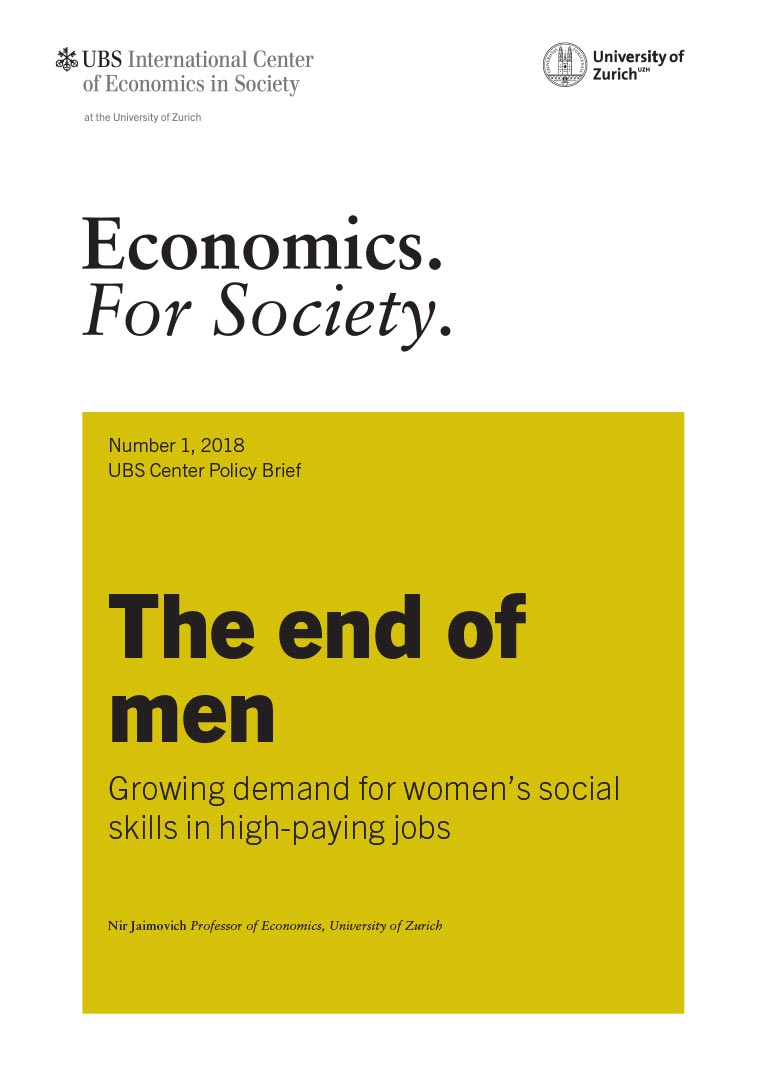
Press
Conclusions
The demand for high-skilled workers who perform cognitive tasks is widely considered to have increased dramatically in the last four decades. Despite this, the probability that a college-educated man was employed in one of these jobs has fallen over that period. This contrasts with the increase in probability experienced by college-educated women, in spite of the larger increase in skilled labor supply among women.
What explains these divergent trends? Research in psychology and neuroscience suggests that women hold a comparative advantage in social skills relative to men. As a result, it is important to understand the relationship between changes in female employment shares within occupations and changes in occupational skill requirements.
We find that a significant fraction of the increase in the share of women in ‘good jobs’ over the last 40 years can be explained by the rising importance of social skills in these jobs. Evidence based on wage data also indicates a clear increase in the returns to social skills over time and across all jobs. This further supports our hypothesis that the US economy has experienced an overall increase in the demand for such skills during this period.
This UBS Center Policy Brief summarizes ‘The “End of Men” and Rise of Women in the High-skilled Labor Market’ by Guido Matias Cortes (York University), Nir Jaimovich (University of Zurich) and Henry Siu (University of British Columbia).
The demand for high-skilled workers who perform cognitive tasks is widely considered to have increased dramatically in the last four decades. Despite this, the probability that a college-educated man was employed in one of these jobs has fallen over that period. This contrasts with the increase in probability experienced by college-educated women, in spite of the larger increase in skilled labor supply among women.
What explains these divergent trends? Research in psychology and neuroscience suggests that women hold a comparative advantage in social skills relative to men. As a result, it is important to understand the relationship between changes in female employment shares within occupations and changes in occupational skill requirements.
Callouts
In detail
A large body of research indicates that over the past four decades – and especially between 1980 and 2000 – the United States experienced a pronounced increase in the demand for high-skilled workers who perform cognitive tasks (see, for example, Violante, 2008; Acemoglu and Autor, 2011; and Beaudry et al, 2016). In my research with Guido Matias Cortes and Henry Siu, we show that the increased demand in the high-skilled labor market has not been distributed equally across genders.
Specifically, we document deterioration in the employment outcomes of high-skilled men since 1980: that is, there has been a fall in the likelihood that a college-educated man is employed in a high-paying cognitive occupation – what we call a ‘good job’. In 1980, 66.2% of male graduates worked in cognitive jobs; but by 2000, that proportion had fallen to 63.3%. This is in stark contrast to the experience of high-skilled women whose likelihood of working in a good job rose. In 1980, 54.2% of college-educated women held such roles; by 2000, that proportion was 58.8%. This is especially striking given that the supply of high-skilled women increased much more than it did for men over this period. These ‘counter trends’ imply that more than half of the initial 12 percentage points gap (66.2% to 54.2%) has been closed (63.3% to 58.8%).
These divergent gender trends are not due to employment growth in occupations dominated by women. Rather, we find that they are explained by an increase in the female share of employment in almost all occupations. While not quite heralding ‘The End of Men’, as an article in The Atlantic labeled the trend for unskilled men (Rosin, 2010), this is a striking shift in the labor market for skilled workers, exactly during the period when the demand for skills increased.
Defining a good job
There are several ways to define a good job. Our first definition categorizes more than 300 distinct occupations as cognitive, routine or manual (see, for example, Acemoglu and Autor, 2011). We define Cognitive occupations, which include general managers, physicians, financial analysts, computer software engineers and economists, as good jobs. These ‘white-collar’ occupations place emphasis on ‘brain’ – as opposed to ‘brawn’ – activities. They involve performing tasks that require greater creativity, analysis and problem-solving skills than others.
Our second definition looks directly at an occupation’s wage ranking. We consider good jobs to be those in the top quarter of the occupational wage distribution, where the mass of each occupation is based on its share of aggregate hours. Unsurprisingly, these two definitions exhibit significant overlap since cognitive occupations tend to occupy the upper tail of the occupational wage distribution. In contrast, routine occupations – such as machine operators, secretaries and administrative assistants – tend to occupy the middle of the wage distribution; and manual occupations – such as janitors, cleaners and home care assistants – the bottom.
Our analysis uses samples of people aged between 20 and 64 in the 1980 and 2000 decennial censuses. This 20-year period saw an enormous increase in the high-skilled population of the United States: a near doubling – from 20.97 million to 40.80 million – of individuals with at least a college degree (see Figure 1). The high-skilled population grew by another 17.51 million between 2000 and 2016. Women accounted for 42% of the high-skilled population in 1980 and for 54% in 2016.
Despite this massive increase, the probability that a high-skilled individual was employed in a cognitive occupation did not fall; it remained constant at 61.1%, as employment in such jobs also doubled But this constancy masks divergent trends in the likelihood of employment in a cognitive occupation across genders.
Comparing men and women
Figure 2 presents the key statistics motivating our analysis. In 1980, 66% of high-skilled men worked in cognitive occupations. Over the next 20 years, this proportion fell by three percentage points to 63%. This fall in the probability of working in a good job was not observed among women. By contrast, the fraction of high-skilled women working in cognitive jobs increased by 4.6 percentage points between 1980 and 2000. This improvement in the likelihood of cognitive employment occurred despite a much larger increase in the number of college-educated women relative to men.
These changes in occupational employment occurred alongside corresponding gender trends in the likelihood of working. For college-educated men, the fall in the likelihood of working in a good job was accompanied by a nearly equal rise in the fraction not working. Similarly, the rising participation rate of high-skilled women was reflected disproportionately in good jobs. This is a further indication of the role of gender-specific processes that favored high-skilled women relative to their male counterparts in good jobs.
Changing demand for social skills
Our theoretical analysis shows that the facts about occupational outcomes can be rationalized by three distinct channels:
- The first channel is a bigger fall in discrimination against women in high-paying cognitive occupations relative to other occupations.
- The second channel is a bigger improvement in women’s skills and productivity relative to those of men.
- The third channel, which is our main focus, is a greater increase in the demand for female-oriented skills relative to male skills – what we refer to as greater ‘female bias’ – especially in high-paying cognitive occupations relative to other occupations.
To put an empirical face on what these ‘female-oriented skills’ could potentially mean, we turn to research evidence from psychology and neuroscience. This indicates that women have a comparative advantage in tasks requiring social skills, such as empathy, communication, emotion recognition and verbal expression (see, for example, Chapman et al, 2006; Woolley et al, 2010; and Koenig et al, 2011). Building on this research, we study whether the demand for social skills within occupations has grown over time (see, also, Deming, 2017 who emphasizes the importance of the level of social skills in understanding occupational employment growth trends). Our hypothesis is that the change in the importance of social skills has been greater in good jobs and that it is thus related to the increasing demand for women versus men in these occupations.
Hence, the appropriate interpretation of our findings is a conditional one: if one is willing to accept the findings from the body of research in psychology and neuroscience – that women have a comparative advantage in tasks requiring social skills (findings that our work does not shed light on per se) – then the increased importance of social skills is one plausible interpretation for the empirical findings of our study, with respect to the labor market outcomes of high-skilled men and women over the past few decades.
Indeed, the primary empirical finding of our study is that increases in relative female employment within occupations are highly correlated with increases in the relative demand for social skills in those occupations, even after controlling for changes in the relative demand for other skills and task characteristics.
To measure changes in the importance of social skills, we use two data sources. The first is the Dictionary of Occupational Titles, which provides detailed measures of ‘temperaments’ that are required to perform the tasks associated with occupations, as well as information on actual work activities. Out of a total of ten temperaments, research has identified four as relating to the importance of social skills:
- Adaptability to situations involving the interpretation of feelings, ideas or facts in terms of personal viewpoint.
- Adaptability to influencing people in their opinions, attitudes or judgments about ideas or things.
- Adaptability to making generalizations, evaluations or decisions based on sensory or judgmental criteria.
- Adaptability to dealing with people beyond giving and receiving instructions.
From these four temperaments, we create a social skills index for each occupation. Importantly, we take advantage of the fact that there have been two waves of the Dictionary of Occupational Titles, the first conducted in 1977 and the second in 1991. This fact allows us to measure the changing importance of social skills within occupations.
Social skills and female employment
Figure 3 shows the relationship between the change in the importance of social skills and the change in the female share of employment for the three broad occupational groups. Cognitive occupations have seen the largest increase (9.2 percentage points) in the proportion of employment of women. They have also seen the largest relative increase in the importance of social skills. Routine occupations have experienced a more modest increase in both their female share and the importance of social skills; while manual occupations have experienced a decline over time in both their female share and the social skills index. We then show that this pattern for broad occupational groups also holds when considering occupations at the much finer level, where we show that high-paying occupations have experienced a greater increase in the importance of social skills compared with lower-paying occupations.
These findings are supported by our second measure of social skills, which draws on a database of nine million newspaper job advertisements between 1940 and 2000. Similarly to above, our measurement is based on the extent of the change in the degree to which workers in an occupation are required to possess social skills. Our results indicate again that changes in thedemand for social skills within an occupation are positively associated with a subsequent increase in the female sharein that occupation.
Skills and wages
The results of our analysis confirm two facts. The first is that high-paying cognitive occupations have experienced an increase in the importance of social skills.
The second is that these same occupations have experienced an increase in the female share of employment relative to other occupations. This relationship between changes in the importance of social skills and in the share of female workers in these occupations is present even when accounting for changes in the cognitive, routine and manual tasks that occupations experienced.
Using wage data to demonstrate an overall increase in the demand for social skills, we show that the returns to social skills, conditional on other characteristics of occupations, increased significantly between 1980 and 2000. We go on to explore the relationship between the skill content of occupations and what are called ‘occupational wage premia’.
For each occupation in each year, we compute the average composition of its workforce along the following five dimensions: gender, age, education, race and nativity. This allows us to calculate the ‘extra wage’ that an occupation pays, on average, after taking account of composition effects.
We then use these occupational wage premia to rule out the possibility of reverse causality; that is, it is not the case that the measured importance of social skills in high-paying occupations has increased as a result of increased female employment. Rather, it is the rising demand for social skills that has increased the share of female employment in good jobs.
Moreover, equipped with these occupational wage premia, we then ask whether the importance of social skills explains the variation in occupational wages – and whether this relationship has changed over time. For female workers, we show that there is a positive and significant relationship between the importance of social skills and the female wage premium, both in 1980 and 2000 (see Figure 4). More importantly, the role of social skills in explaining the wage premium has doubled over time.
For male wages, the change in the importance of social skills is even more striking. Specifically, the effect of social skills for men is small and insignificant in 1980, but it is positive and significant in 2000 and it explains a much larger fraction of the occupational wage premia (see Figure 4). We then repeat this same analysis between 2000 and 2016. We find that the importance of social skills has stabilized and remained as important, while the returns to routine and manual skills have fallen.
A large body of research indicates that over the past four decades – and especially between 1980 and 2000 – the United States experienced a pronounced increase in the demand for high-skilled workers who perform cognitive tasks (see, for example, Violante, 2008; Acemoglu and Autor, 2011; and Beaudry et al, 2016). In my research with Guido Matias Cortes and Henry Siu, we show that the increased demand in the high-skilled labor market has not been distributed equally across genders.
Specifically, we document deterioration in the employment outcomes of high-skilled men since 1980: that is, there has been a fall in the likelihood that a college-educated man is employed in a high-paying cognitive occupation – what we call a ‘good job’. In 1980, 66.2% of male graduates worked in cognitive jobs; but by 2000, that proportion had fallen to 63.3%. This is in stark contrast to the experience of high-skilled women whose likelihood of working in a good job rose. In 1980, 54.2% of college-educated women held such roles; by 2000, that proportion was 58.8%. This is especially striking given that the supply of high-skilled women increased much more than it did for men over this period. These ‘counter trends’ imply that more than half of the initial 12 percentage points gap (66.2% to 54.2%) has been closed (63.3% to 58.8%).
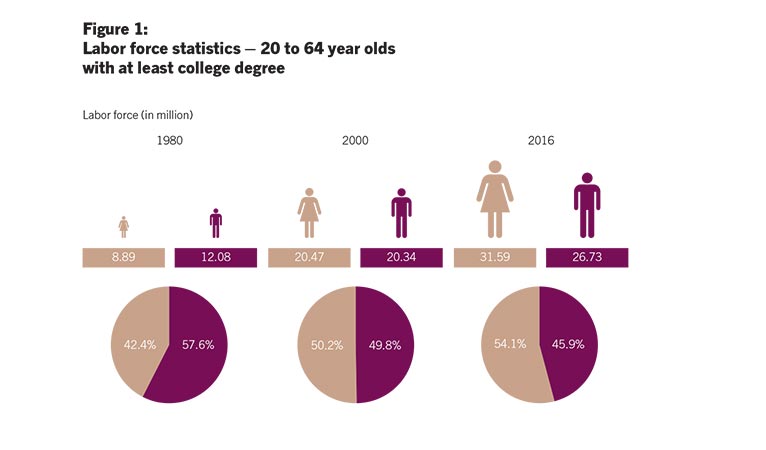
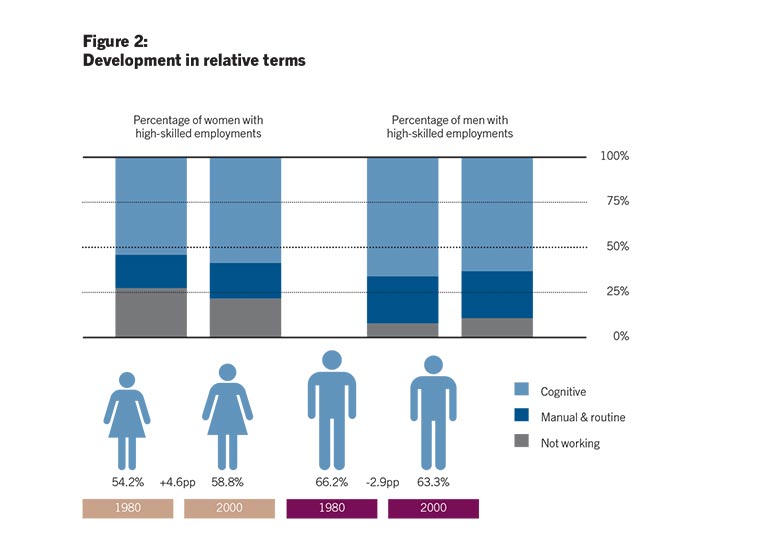
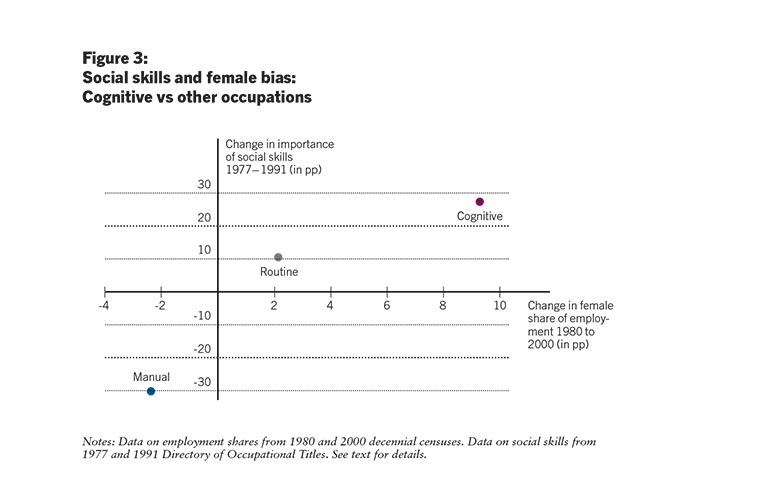
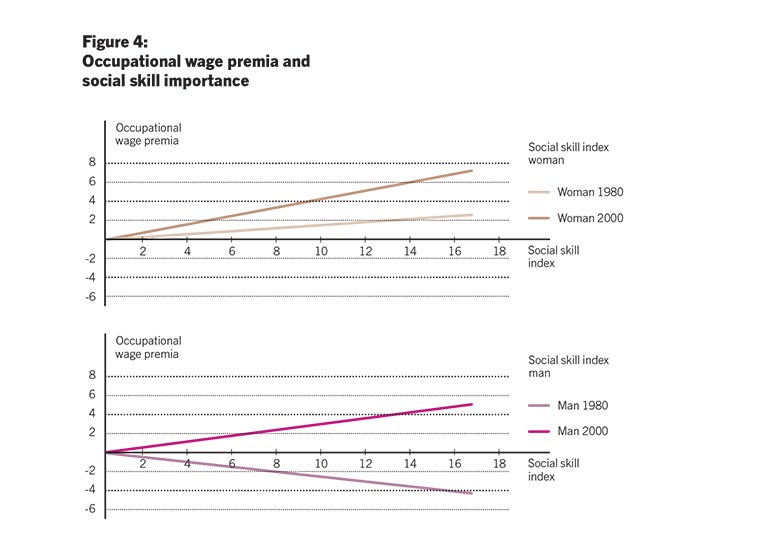
Further reading
Acemoglu, Daron, and David Autor (2011) ‘Skills, Tasks and Technologies: Implications for Employment and Earnings’, in Handbook of Labor Economics Vol. 4B edited by Orley Ashenfelter and David Card, Elsevier.
Autor, David, and David Dorn (2013) ‘The Growth of Low Skill Service Jobs and the Polarization of the U.S. Labor Market’, American Economic Review 103(5): 1553-97.
Beaudry, Paul, David Green and Benjamin Sand (2016) ‘The Great Reversal in the Demand for Skill and Cognitive Tasks’, Journal of Labor Economics 34(S1): S199-247.
Chapman, Emma, Simon Baron-Cohen, Bonnie Auyeung, Rebecca Knickmeyer, Kevin Taylor and Gerald Hackett (2006) ‘Fetal Testosterone and Empathy: Evidence from the Empathy Quotient (EQ) and the “Reading the Mind in the Eyes” Test’, Social Neuroscience 1(2):135-48.
Cortes, Guido Matias, Nir Jaimovich, Christopher Nekarda and Henry Siu (2015) ‘The Micro and Macro of Disappearing Routine Jobs: a Flows Approach.’
Deming, David (2017) ‘The Growing Importance of Social Skills in the Labor Market’, Quarterly Journal of Economics.
Koenig, Anne, Alice Eagly, Abigail Mitchell and Tiina Ristikari (2011) ‘Are Leader Stereotypes Masculine? A Meta-analysis of Three Research Paradigms’, Psychological Bulletin 137(4): 616-42.
Rosin, Hanna (2010) ‘The End of Men’, The Atlantic.
Violante, Giovanni (2008) ‘Skill-biased Technical Change’, in The New Palgrave Dictionary of Economics edited by Steven Durlauf and Lawrence Blume, Palgrave Macmillan.
Woolley, Anita Williams, Christopher Chabris, Alex Pentland, Nada Hashmi and Thomas Malone (2010) ‘Evidence for a Collective Intelligence Factor in the Performance of Human Groups’, Science 330: 686-88.
Author
Nir Jaimovich received his PhD from Northwestern University in 2004. He works on macroeconomics questions with special emphasis on business cycles, labor markets, and the macroeconomic implications of micro product level data and was head of the NBER price dynamics group (together with Bob Hall). Within these research areas, he combines new data and quantitative theories to tackle long-standing macroeconomic questions. In the area of labor/macro his work shows how demographic composition and occupation structure of the economy shape the dynamics of the business cycle. In addition, his work examines the empirical and theoretical plausibility of signals and uncertainty about future economic fundamentals functioning as important drivers of business cycles. Finally, his micro-pricing product-level data shows how actual firms’ pricing strategies shapes the insights regarding the extent that monetary policy has an impact on the economy. His work has found large resonance inside and outside academia and was featured within policy circles (such as White House official publications) and media outlets such The New York Times, Washington Post, The Economist, the Financial Times, the Wall Street Journal, the Guardian, Forbes, Swiss and German media.
Nir Jaimovich received his PhD from Northwestern University in 2004. He works on macroeconomics questions with special emphasis on business cycles, labor markets, and the macroeconomic implications of micro product level data and was head of the NBER price dynamics group (together with Bob Hall). Within these research areas, he combines new data and quantitative theories to tackle long-standing macroeconomic questions. In the area of labor/macro his work shows how demographic composition and occupation structure of the economy shape the dynamics of the business cycle. In addition, his work examines the empirical and theoretical plausibility of signals and uncertainty about future economic fundamentals functioning as important drivers of business cycles. Finally, his micro-pricing product-level data shows how actual firms’ pricing strategies shapes the insights regarding the extent that monetary policy has an impact on the economy. His work has found large resonance inside and outside academia and was featured within policy circles (such as White House official publications) and media outlets such The New York Times, Washington Post, The Economist, the Financial Times, the Wall Street Journal, the Guardian, Forbes, Swiss and German media.